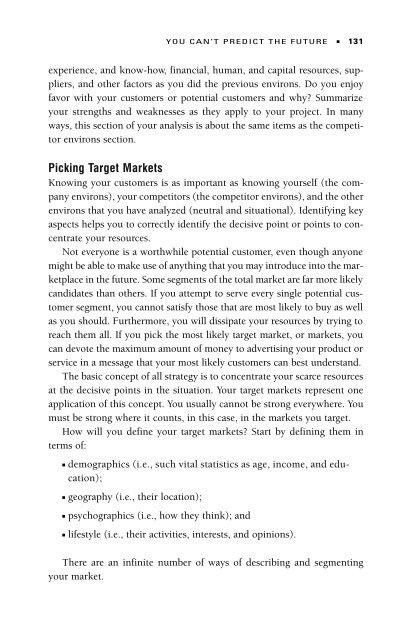A Class with Drucker - Headway | Work on yourself
A Class with Drucker - Headway | Work on yourself
A Class with Drucker - Headway | Work on yourself
Create successful ePaper yourself
Turn your PDF publications into a flip-book with our unique Google optimized e-Paper software.
experience, and know-how, financial, human, and capital resources, suppliers,<br />
and other factors as you did the previous envir<strong>on</strong>s. Do you enjoy<br />
favor <str<strong>on</strong>g>with</str<strong>on</strong>g> your customers or potential customers and why? Summarize<br />
your strengths and weaknesses as they apply to your project. In many<br />
ways, this secti<strong>on</strong> of your analysis is about the same items as the competitor<br />
envir<strong>on</strong>s secti<strong>on</strong>.<br />
Picking Target Markets<br />
Knowing your customers is as important as knowing <strong>yourself</strong> (the company<br />
envir<strong>on</strong>s), your competitors (the competitor envir<strong>on</strong>s), and the other<br />
envir<strong>on</strong>s that you have analyzed (neutral and situati<strong>on</strong>al). Identifying key<br />
aspects helps you to correctly identify the decisive point or points to c<strong>on</strong>centrate<br />
your resources.<br />
Not every<strong>on</strong>e is a worthwhile potential customer, even though any<strong>on</strong>e<br />
might be able to make use of anything that you may introduce into the marketplace<br />
in the future. Some segments of the total market are far more likely<br />
candidates than others. If you attempt to serve every single potential customer<br />
segment, you cannot satisfy those that are most likely to buy as well<br />
as you should. Furthermore, you will dissipate your resources by trying to<br />
reach them all. If you pick the most likely target market, or markets, you<br />
can devote the maximum amount of m<strong>on</strong>ey to advertising your product or<br />
service in a message that your most likely customers can best understand.<br />
The basic c<strong>on</strong>cept of all strategy is to c<strong>on</strong>centrate your scarce resources<br />
at the decisive points in the situati<strong>on</strong>. Your target markets represent <strong>on</strong>e<br />
applicati<strong>on</strong> of this c<strong>on</strong>cept. You usually cannot be str<strong>on</strong>g everywhere. You<br />
must be str<strong>on</strong>g where it counts, in this case, in the markets you target.<br />
How will you define your target markets? Start by defining them in<br />
terms of:<br />
■ demographics (i.e., such vital statistics as age, income, and educati<strong>on</strong>);<br />
■ geography (i.e., their locati<strong>on</strong>);<br />
■ psychographics (i.e., how they think); and<br />
YOU CAN’T PREDICT THE FUTURE ■ 131<br />
■ lifestyle (i.e., their activities, interests, and opini<strong>on</strong>s).<br />
There are an infinite number of ways of describing and segmenting<br />
your market.


